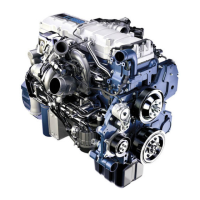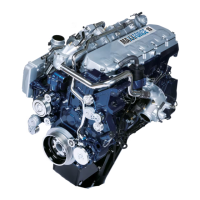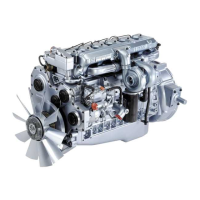4 ENGIN E SY M PTOMS DIAGNOSTICS 137
Smoke
Two types of smoke conditions can occur, black and
white. Dark-gray smoke is considered black smoke.
Light-blue smoke is considered white smoke.
Refer to the following corresponding smoke condition
for symptom, c ause, and diagnostic procedure.
Black Smoke
Cause
• Air intake or exhaust restriction
• Turbocharger failure, turbocharger blade damage
or turbocharger wheel stuck
• Loose or failed injector
• Altitude (black smoke on hard acceleration or
snap acceleration may be more pronounced at
higher elevations)
• Failed Manifold Absolute Pressure (MAP) sensor
• Failed E xhaust Back Pressure (EBP) sensor
• Failed Injection Control Pressure (ICP) sensor
Procedure
1. If engine has fuel knock or there is evidence of
fuel in the exhaust, remove exhaust manifolds and
inspect for fuel in the exhaust ports. (Suspect
loose injectors, missing or damaged O-ring and
gasket on bottom of injector).
2. Inspect air inlet system and e xhaust system for
possible sources of restriction.
3. Inspect turbocharger for oil leakage or failure of
blades.
4. Do Test 7 (Intake Restriction) on Performance
Diagnostics form or in Section 6 of this manual.
5. Do Test 8 (Exhaust Restriction) on Performance
Diagnostics form or in Section 6 of this manual.
White Smoke
Cause
•Coldengine
• No Intake Air Heater (IAH) operation
• Poor quality fuel
• EGRstuckopenonstartup
• EGR cooler leaking coolant into exhaust
• Loose or failed injector
• Bent connecting rods
• Wornpistonrings
•Lowcompression
• Coolant leaking into the intake manifold through
the cylinder head cup plugs
• Coolant leaking into combustion chamber
• Aerated fuel
Procedure
1. In cold ambient temperatures, some white smoke
is normal until the engine is up to operating
temperat ure.
• Ensure that engine is up to operating
temperature 88 °C (190 °F) prior to verifying
a white smoke complaint.
• If the engine is unable to obtain operating
temperat ure du rin g a road test, verify
thermostat opening temperature 88 °C (190
°F).
2. Do Test 15 (Inlet Air Heater System) on Hard Start
and No Start Diagnostics form to verify inlet air
heater operation.
3. Do Test 5 (Fuel) on Performance Diagnostics
form. Verify quality and quantity of diesel fuel.
Poor quality fuel or low cetane rating can cause
white smoking, engine misfire and low power.
See Engine Operation and Maintenance Manual,
Fuel Requirements section for model and year
of engine to determine minimum necessary fuel
grade and cetane rating.
4. Do Test 6 (Fuel Pressure and Aerated Fuel) on
Performance Diagnostics form to verify aerated
fuel.
5. Do Test 11 (Injector Disable) and Test 12 (Relative
Compression) on Performance D iagnostics form
to identify failed injector or weak power cylinder.
6. Do Test 16 (Crankcase Pressure) to measure
condition of power cylinders.
EGES-270-1
Read all safety instructions in the "Safety Information" section of this manual before doing any procedures.
Follow all warnings, cautions, and notes.
© August 2008 Navistar, Inc.

